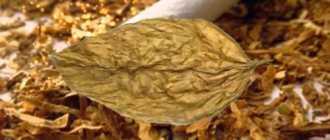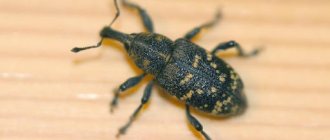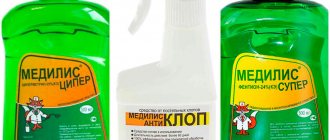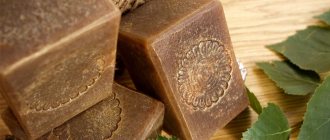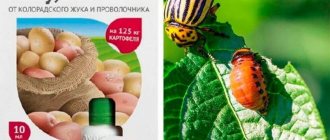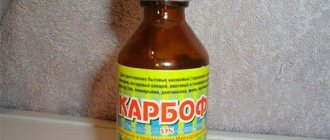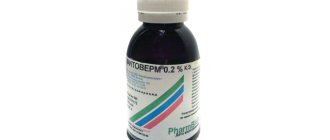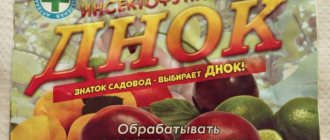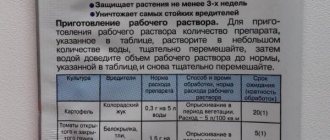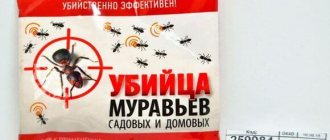The Colorado potato beetle is a pest that causes irreparable damage to the potato crop. Modern developers of plant protection products against pests have created a large number of drugs that can fight this pest. Among them is the insecticide Marshall. However, unlike its analogues, its peculiarity is that Marshall can be either sprayed on the crop or applied to the soil.
In addition to fighting the Colorado potato beetle, Marshall is an excellent protector against pests of cabbage, cucumbers, tomatoes, and fruit trees. The insecticide effectively destroys insect pests due to its acaricidal and aphicide properties, which allows you to protect the plant for a long time.
We recommend similar posts:
Insecticide Gardener BT
Insecticide Herold
Instructions for use
Processing of crops must be carried out during their growing season. It can be carried out in two ways: irrigating the soil and spraying the above-ground part of the crop. Thus, Marshall is able to effectively combat ground and soil pests, sucking and gnawing insects. In addition, the insecticide is characterized by nematicidal properties. The time of protective action when applied in soil lasts approximately 45 days, when sprayed - 15-20 days. The waiting time for potatoes is more than 20 days.
Only 1 treatment is carried out per season. The working substance is prepared at the rate of 7 ml of Marshall emulsion concentrate per 10 liters of water. For a more effective action of the insecticide, it is recommended to apply it together with mineral fertilizers.
Composition and release form of the Marshall insecticide
Marshall is a drug against pests of garden and vegetable crops, which contains the active substance carbosulfan. It is this component that provides the effective insecticidal, acaracidal and nematicidal effect of the drug. Carbosulfan belongs to the second class of toxicity.
Marshall insecticide is available in the form of an emulsion concentrate or granules intended for application to the soil.
The first product contains 25% of the active substance, the second – from 5 to 10%. The emulsion concentrate is intended for treating plants; granules are added to the soil.
Consumption rate
| Processed crops | Insect pests | Insecticide consumption rate |
| Potatoes, tomatoes, cucumbers, strawberries | Colorado potato beetle, potato moth | 7-10 ml per 10 liters of water |
| Cabbage | Cutworms, cabbage fly, aphid, flea beetle | 8-10 ml per 10 liters of water |
| Fruit trees (pear, apple, cherry, cherry, peach, plum) | Apple flower beetle, cherry fly, plum fly, aphid, bud beetle, leaf roller | 8-10 ml per 10 liters of water |
The principle of action of the drug
Marshall is a preparation for plants that protects them from various insect pests, as well as nematodes. The insecticidal agent has an intestinal contact effect. This means that pests die both when they eat the treated plants and during any contact with the active substance.
After spraying, the active substance penetrates the green parts of the plant, spreads through its tissues, penetrates the seeds and root system.
The drug Marshall begins to act immediately after treatment, maintaining insecticidal activity for up to 35-45 days.
Basic recommendations for the use of the drug Marshall:
- Colorado potato beetles;
- mole crickets;
- wireworms;
- aphid;
- roundworms and their larvae;
- locusts;
- bread ground beetle;
- potato moth;
- apple flower beetle;
- leaf roller;
- gnawing cutworm;
- cherry, cabbage and plum flies.
The advantage of the drug Marshall is that it is well tolerated by all types of garden and vegetable plants and retains insecticidal activity regardless of weather conditions.
Basic properties
The main characteristics of the drug against the Colorado potato beetle and other pests “Marshal” are:
- the presence of a wide range of applications - the destruction of ground and soil pests, gnawing and sucking insects;
- the presence of a persistent protective effect that lasts for 45 days during subsoil treatment and for 2-3 weeks during the spraying procedure;
- ability to work in high temperature conditions;
- the presence of a high degree of toxicity, requiring all necessary precautions to be taken;
- the duration of the warranty period is at least 36 months from the date of manufacture of the drug;
- ease of preparation of the working substance, which consists in dissolving 7 milliliters of concentrated emulsion in 7-10 liters of water;
- compatibility with the main types of insect pest control products - herbicides, fungicides, mineral fertilizers. The exception is substances containing sulfur and alkalis.
Safety at work
You can work with poison only in special clothing, rubber gloves, waterproof headgear, glasses, and a respirator.
After completing the spraying, be sure to take a hot shower and brush your teeth.
An aqueous solution can only be prepared outdoors and in calm weather.
Danger to humans
This insecticide is a very strong poison. When it enters the human body, copious amounts of saliva are initially observed, and soon severe abdominal pain occurs. Then vomiting and stomach upset appear. The pupils narrow greatly, the person quickly weakens, dizziness occurs, and a migraine develops.
As you can see, this is a very serious poisoning, for which you should definitely consult a doctor.
First aid for poisoning
If you feel the slightest discomfort, all work with this drug should be stopped immediately.
The first thing to do is drink a few glasses of water and artificially induce vomiting.
Next, be sure to take three tablets of activated carbon and call an ambulance.
If the product gets on your skin or eyes, rinse it off with plenty of water.
How to use it correctly
The drug is intended for pre-planting treatment of tubers in two ways: spraying before germination and treatment before planting in the ground. Both methods are equally effective, so the choice is up to the gardener.
Instructions for preparing the solution and processing methods
Before starting to process the tubers before germination, the seeds are removed from storage 20-25 days before planting and left to warm up at a temperature of +15°C for 24 hours. Then prepare a working solution, which is used immediately: 10 ml of the product is diluted in 100 ml of water and mixed until smooth. This volume is enough to process 10 kg of potatoes. A measuring cup will help you accurately measure the right amount of liquid.
The seeds are laid out on plastic film in one layer and sprayed with a solution using a spray bottle on both sides. The tubers are left until completely dry and placed in boxes for germination.
The advantage of this method is the formation of strong and healthy shoots. Disadvantage - the validity period of the product is reduced, and young tubers are left without protection during the period of active growth.
Reference. The working solution turns the potatoes red, so they cannot be confused with untreated tubers.
The second treatment method involves spraying the seeds with a protective solution 3 hours before planting. The concentration of the working solution is the same. The action is carried out at a safe distance from other garden crops. A film is spread on the ground, the tubers are laid in an even layer and the processing is carried out. The seeds are left to dry for 30-60 minutes.
The advantage of this method is a longer period of protection compared to the first method.
Important! The drug is used to treat seeds of mid-season and late varieties of potatoes. Spraying tubers of early varieties is undesirable: the chemical will not have time to be neutralized before harvesting
If the wireworm spreads over a large area, the concentration of the solution should be maximum. When using the drug together with other protective drugs, it is necessary to ensure the compatibility of the chemical elements and the advisability of simultaneous use.
Precautionary measures
Despite the fact that “Prestige” is classified as a safe chemical with minimal harm to humans, insects and birds, the manufacturer advises taking precautions when spraying planting material:
- carry out the manipulation in protective clothing, rubber gloves, a respirator and goggles, then take a shower and change clothes;
- If the substance gets into your eyes, rinse immediately with plenty of clean water;
- if a chemical gets into the esophagus, rinse the stomach, take an adsorbent, and seek medical help;
- It is forbidden to process tubers with traces of rot, this leads to a decrease in germination;
- Process freshly cut tubers only after dipping in ash and tightening the cut;
- You cannot spray the solution on the above-ground parts of plants, since the toxic substances will not have time to decompose into safe components.
Effect duration
“Prestige” is characterized by the rapid entry into the activity phase, which reaches its peak 3-4 hours after treatment. The effectiveness of protection lasts for 1.5-2 months.
Period of action of the drug after germination:
- from the Colorado potato beetle - 37 days;
- from aphids - 39 days;
- from wireworms - throughout the growing season;
- fungicidal protection - until the end of the season.
Advantages and disadvantages of using the drug Marshall
The insecticidal drug Marshall is widely used among many summer residents and farmers, as it has a number of advantages over similar products.
The main advantages of the Marshall insecticide:
- can be used for all types of garden and vegetable crops;
- effective against insect pests at any stage of their development, from larvae to adults;
- even with repeated use, insects do not develop an addiction to the active ingredient of the drug Marshall;
- when sprayed with a working solution, the insecticidal effect lasts up to 35 days, when adding granules to the soil - up to 45 days;
- the drug begins to act immediately after treating plants or soil;
- weather conditions do not affect the effectiveness of the Marshall insecticide.
The insecticidal drug Marshall also has several disadvantages. First of all, it is highly toxic to fish, birds, bees and other beneficial insects. In addition, this product is not intended for use near bodies of water or in greenhouse conditions.
Marshall is a highly effective insecticide designed to protect garden and vegetable plants from insect pests. When used correctly, taking into account all the requirements of the instructions, the drug will help get rid of the Colorado potato beetle, mole cricket, wireworm, aphids and other dangerous and common pests of cultivated plants.
Marshal
Under the name “Marshal”, 2 pesticides are sold in the post-Soviet countries: one is produced by the American company FMC, the other is produced at the Polish enterprises of the international company Sumi-Agro.
These drugs differ radically in both composition and dosage. Since the American “Marshal” is one of the few inexpensive products effective against potato nematodes, unscrupulous sellers pass it off as a Polish insecticide, which does not have such properties.
In addition, a liquid based on chlorpyrifos, packaged in 100 ml bottles, has been spotted on sale. The manufacturer is unknown, but none of the “Marshals” contain such a compound, so you need to treat the drug with extreme caution, and ask for a certificate when purchasing.
American drug "Marshal"
"Marshal" is a systemic insecticide of enteric contact action with nematicidal and acaricidal properties. The active substance of the drug is carbosulfan, which belongs to the chemical class of carbamates.
This compound is effective against most potato pests: the Colorado potato beetle at all stages of its development, wireworm, mole cricket, and nematode.
Carbosulfan has a contact effect, but after 2–5 days it degrades, releasing the extremely toxic systemic insecticide carbofuran.
The product is produced by the American company FMC. Release forms:
- emulsion concentrate (carbosulfan content – 250 g/l). The drug is packaged in ampoules of 7 ml, bottles of 100 ml and 1 l;
- water-dispersible granules (carbosulfan concentration – 50 g/kg and 100 g/kg).
Wettable powder “Marshal”, produced in Estonia, is sometimes available on sale; the carbosulfan content is 250 g/l. The American one does not produce “Marshal” in this form. Producing powder is less cost-effective than producing granules or emulsion concentrate. However, it is possible that the powder is produced under license, so when purchasing, you must require a certificate.
Features of the drug use
The emulsion concentrate is used for spraying. To treat 100–200 m² of potato plantation, 7–10 ml of emulsion concentrate is dissolved in 10 liters of water. Spraying is carried out in the morning or evening, in dry, windless weather. Only 1 treatment is allowed per season.
To combat the mole cricket, wheat cereal is cooked.
The cooled porridge is transferred to a glass or enamel bowl and mixed with an insecticide dissolved in a small amount of water (7 ml of “Marshal” is added to the porridge from 250 g of cereal, this amount is enough for 2-3 acres).
For flavor, season the porridge with 1–2 tablespoons of unrefined sunflower oil. In the row-spacings, transverse grooves are made at a distance of 20 cm from each other. 5–10 grains of poisoned porridge are thrown into each groove.
The duration of the protective period of the emulsion concentrate is 2–3 weeks. It is allowed to harvest potatoes no earlier than a month after using the product.
To combat nematodes and wireworms, granules are applied to the soil using special devices (according to the dosage specified in the instructions). Carbosulfan is very toxic and slowly decomposes in soil. Therefore, if possible, it is better to leave the treated area fallow and plant potatoes after a year.
But it is allowed to add granules to the soil after planting the tubers (immediately or after a few days). If there are no special devices, some farmers successfully fight the nematode by adding a solution of granules using a drip irrigation system. The period of protective action of the drug is 45 days, so it cannot be used when growing very early potatoes.
The harvest can be harvested no earlier than 2 months after applying “Marshal” to the soil. It is not recommended to mix Marshall with alkaline or sulfur-containing pesticides.
Possible harm to "Marshal"
"Marshal" with carbosulfan is prohibited for use in some European countries, in particular in Ukraine. The reason is that carbofuron (a decomposition product of the active substance) is many times more toxic than carbosulfan itself. Carbofuron can accumulate in the soil.
True, the reaction with the formation of carbofuron occurs only in the body of insects. For warm-blooded animals, carbosulfan is less dangerous.
“Marshal” belongs to the II class of danger for people and to the I class for bees. The product is very dangerous for fish and birds.
The drug is recommended to be used only if all other insecticides do not help.
If it is impossible to get a real “Marshal”, you should not buy fakes: “Nematorin” is successfully used to destroy the nematode, and “Fitoverm”, Smart Grow Softguard are used to limit its population.
To work with “Marshal” you must wear a protective suit, respirator, gloves and goggles. Carbosulfan vapors are hazardous to the respiratory tract. If they inhale the product or become poisoned, they should consult a doctor immediately.
Polish drug "Marshal"
Insecto-fungo-stimulator "Marshal" produced by Sumi-Agro contains 3 active ingredients:
- acetamiprid (200 g/kg) is a systemic insecticide with enteric contact action from the class of neonicotinoids. The compound provokes paralysis and death of the Colorado potato beetle, potato ladybug, and whitefly;
- mancozeb (300 g/kg) is a contact fungicide with acaricidal properties from the class of dithiocarbamates. The substance protects plants from late blight and alternaria, suppresses the development of whitefly and spider mite larvae.
- Poteytin (2 g/kg) is a growth regulator that strengthens potato immunity.
Using Taboo
Most people who fight against the Colorado potato beetle do not know how to use Taboo correctly. Therefore, before using the drug, every vegetable grower should read the instructions for use of this protective insecticide.
Creating a solution for spraying root crops
First, all seed material is laid out on a tarpaulin or plastic film in one layer. It is better not to stack root vegetables in several layers, as this will complicate their processing.
When all the tubers are neatly laid out, you can start preparing the working solution. When creating a mixture for potatoes, 15 ml of the drug and 500 ml of warm water are added to a small non-food container. After the poison dissolves in the liquid, another one and a half liters of water is poured into the container with the solution. Before using Tabu, the mixture is thoroughly stirred and infused for 15 minutes.
Spraying root crops
It is recommended to spray planting potato tubers on the day of creating the working liquid for treatment. Therefore, it is not recommended to leave the prepared mixture for long-term storage. When treating root vegetables with the drug, you will have to turn them 2-3 times so that the liquid is evenly distributed over the entire surface. Two liters of liquid should be enough to process 130 potatoes.
After treating the potatoes with Tabu, they should be given half an hour to dry. You can plant seed in the holes only after they have completely dried.
Preparation of a mixture for tillage
Some gardeners prefer to process not the tubers, but the soil in the holes before planting. To do this, you will have to create a working solution, which is prepared differently and has a completely different concentration.
To create an effective protective mixture and spray the soil with it, add 4 ml of insecticide to a ten-liter container of water. This amount of liquid is enough to spray one hundred square meters of garden plot. For large areas, 25 liters of working mixture are prepared. In this case, a whole bottle of Tabu is added to a 25 liter container.
You can determine the optimal dosage of the drug for any area of the site yourself. First, the amount of the drug to prepare the working mixture is determined. To do this, the area in acres is multiplied by four and the resulting number will be the amount of protective agent that is added to the water. To determine the optimal volume of water, the number of acres is multiplied by ten.
Soil treatment
Before using the drug Tabu VSK for processing potatoes, holes are prepared for planting potatoes. Then the working mixture is prepared and added to the sprayer. As a sprayer, you can use models that consist of a telescopic fire hose.
When spraying, each hole is treated so that all seedlings are protected from the Colorado potato beetle. When each of the holes is sprayed, tubers are planted in them and covered with soil.
Efficiency
Reviews about Marshall are mostly positive.
We bought various poisons for the Colorado potato beetle, but Marshall was my favorite. We decided on it. For 5 years, I had to spray potatoes against pests several times a season. Marshal was treated only once, before flowering. These pests were never seen again. In addition to the colorados, the product saved us from cabbage grass, aphids, and many other pests. A wonderful product, I recommend it to everyone!
The larvae die instantly. While I walked through the entire garden, I came back, at the beginning of the beds there were no more beetles. In 2 hours it destroys everyone, the protection lasts all season. Convenient form - granules. It dissolves well, there is no strong pungent odor. I work with gloves, but without a respirator. There was never any poisoning. I try not to let the splashes fall on me. A very effective drug at an affordable price.
You can buy the product in a specialized store, or you can order it online. The cost of one ampoule is 20 rubles, there are 5 of them in a package. The price of the drug is 100 rubles. Should be stored in a dark place, away from sunlight. Use within 3 years from date of manufacture.
Storage period and conditions
Under proper conditions and stored in original packaging, the shelf life is 3 years. Store in a dry place, avoid exposure to sunlight.
The drug should not be near food products or medicines. Contact of children with insecticide is strictly prohibited!
Insecticide "Marshal" is a powerful remedy against pests. It should be used carefully. It is important to remember that although plants tolerate it well, the drug significantly reduces their immunity.
It is best to use the product when the infestation is large enough or when the pests already react poorly to other chemicals.
Precautionary measures
When working with Marshall insecticide, you must follow personal safety rules. Its main active component, carbosulfan, is a volatile substance belonging to the second class of toxicity. When it breaks down, it forms chemicals that are highly toxic.
Basic rules for working with the drug Marshall:
- Processing plants or adding granules to the soil should be carried out only with the use of personal protective equipment - rubber gloves, a respirator, goggles.
- While spraying plants with insecticide, do not drink, smoke or eat food.
- After completing the work, you need to wash your face, wash your hands with warm water and soap, and rinse your mouth.
- The insecticide must not be used in residential areas. The working solution should be prepared only in the open air.
- The drug Marshall is toxic to bees, fish, beneficial insects and some birds. That is why you cannot use an insecticidal solution near an apiary or fish pond.
Treatment with Marshall should only be carried out in dry, windless weather, preferably in the morning or evening.
Chemicals for pest control
In the garden and vegetable garden, a person grows food. And it just so happened that it was in this area that the interests of people and a huge army of insects crossed, which immediately chose cultivated plants for their food. By feeding on various parts of vegetable and fruit plants, insects can not only significantly reduce the yield, but also completely destroy it, and even destroy the plants. Therefore, whether you like it or not, we are forced to protect what we grow.
When other means fail, insecticides are used.
First, we try to scare away harmful insects or drive them out of our area. Then biological methods, folk remedies, and the attraction of natural enemies from the world of plants and animals are used. But often they all turn out to be ineffective, and then you have to resort to chemicals. Let's look at this “arsenal” in more detail.
